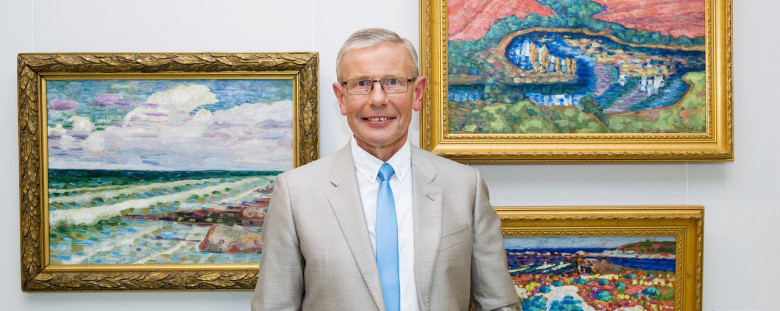Enn Kunila, the owner of one of the finest art collections in Estonia, has initiated an extensive search campaign to find works by expressionist painter Konrad Mägi.
Collaborating with the Estonian Television’s “Eyewitness” programme, Kunila is hoping to find works by Mägi (1878-1925) that are unknown to this day.
Mägi painted 400 paintings over the course of his lifetime, but the locations of only about two hundred paintings are currently known. Even assuming that half of the missing paintings were destroyed in wars and cataclysms, it is estimated that there may be about 100 paintings, the locations of which are hitherto unknown.
His paintings could have been left abroad at the time of his painting trips in different places in Europe. It is also known that paintings by Mägi were taken along when people left Estonia during World War II. “In order to search for such paintings, I appeal for assistance to the Estonian community and the congregations of churches associated with Estonians to conduct a corresponding extensive information campaign,” Kunila told Estonian World.
One of the most important painters in the Estonian art history
Mägi is considered one of the most important painters in the Estonian art history. Although his creative career lasted only 20 years, he had a significant impact on the art scene of his time and on subsequent developments. Primarily known for his landscape paintings, he was one of the most colour-sensitive Estonian painters of the first decades of the 20th century. Mägi’s works on motifs of the Saaremaa island were also the first modern Estonian nature paintings.
Born in Rõngu Parish, southern Estonia, Mägi received his elementary art education from the drawing courses of the German Artisans’ Society of Tartu. He continued his art education as an unattached student in St Petersburg, studying under Amandus Adamson, a renowned Estonian sculptor and painter. In 1906, he spent the summer in Åland, Finland, together with his friendly circle of painters and writers. It was there that the 27-year-old Mägi started painting more seriously for the first time.
As was customary for artists of the time, Mägi also went to Paris, studying there at a free academy in 1907. After subsequent trips to Normandy (France) and Norway, he returned to Estonia in 1913 and founded the Pallas Art School in Tartu, which turned into the training ground for dozens of future artists. Mägi travelled to Europe once again in the early 1920ies, but his premature death in 1925 sadly ended his intensive, productive and varied career as an artist.
Every art collection is an inseparable element of the national culture
For Kunila, the search for Mägi’s works is part of a larger – and it is probably fair to say, lifetime – mission, as he has actively collected and popularised the art of Estonian classical painting through various enterprises for the last 20 years. His art collection is now so extensive that it is comparable to the permanent exhibitions of Estonian art museums concentrating on the same era.
“My interest in art began in my childhood when I visited art exhibitions for the first time with my mother. I remember from that time to the present the emotion I felt when I saw the paintings so rich in colour of Estonia’s most famous painter Konrad Mägi. My interest in art grew and evolved over the years, regardless of the fact that I work as a businessman and I have no specialised education in art,” Kunila said.
Kunila considers his duty to collect the works of the most important Estonian painters. “I believe that in a small country like Estonia, every bigger art collection is also an inseparable element of the national culture. Hence, every art collector not only has the right, but also the duty to disclose their collection, to both art scholars and the researchers, but first and foremost to the wider public.”
To uphold these principles, Kunila has organised exhibitions, published catalogues and books and supported the publication of monographs. “I really like the idea of art as Estonia’s calling card. We can be proud as Estonians that we have had such great painters as Konrad Mägi, Nikolai Triik, Johann Köler, Ants Laikmaa, Ado Vabbe, Elmar Kits and many others. The works of these artists could enrich the walls of every art museum in the world,” he said.
Two exhibitions in Italy
This year, Kunila is involved with two exhibitions in Italy. First off, an exhibition of works from the golden age of Estonian painting (1910-1940) is being held until 21 May 2017 at the Museo Novecento in Florence, where ten paintings by Konrad Mägi are also on display, in a separate hall.
A solo exhibition of Mägi’s works – where about 50 paintings will be put on display – will be opened on 9 October 2017 at the Galleria Nazionale d’Arte Moderna Museum in Rome. Kunila is also publishing a biography of Mägi, in time for the Rome exhibition.
“Therefore I am very grateful for any information that may supplement the heritage of Konrad Mägi. If a painting by Mägi is in your possession, or if you know the location of a painting by Mägi that has thus far been concealed from the public, you are kindly asked to contact me,” Kunila said.
I
Cover: Konrad Mägi – Landscape with Pink Fields, 1915-1916. Pictures courtesy of Enn Kunila’s Art Collection.





